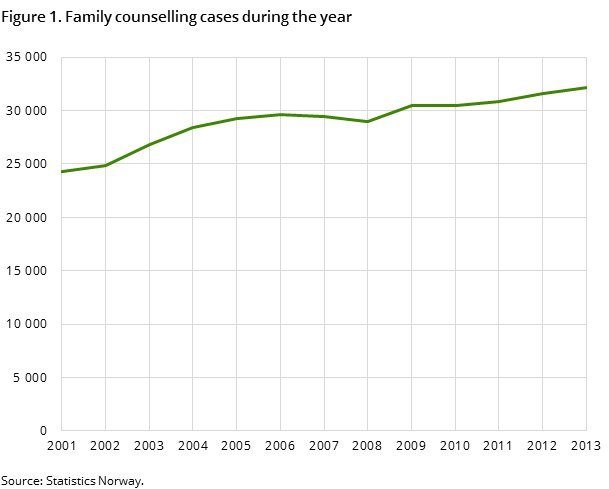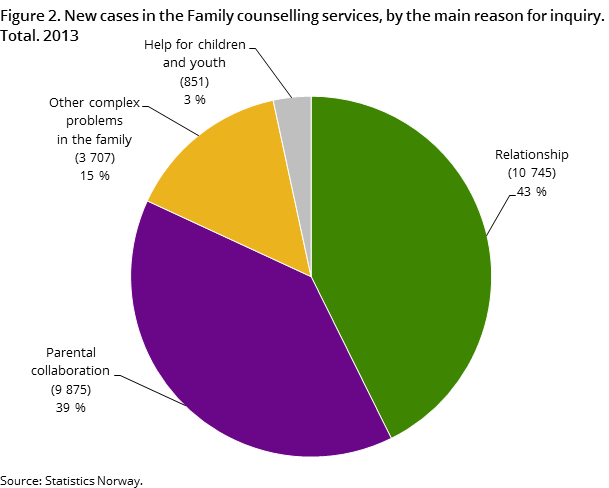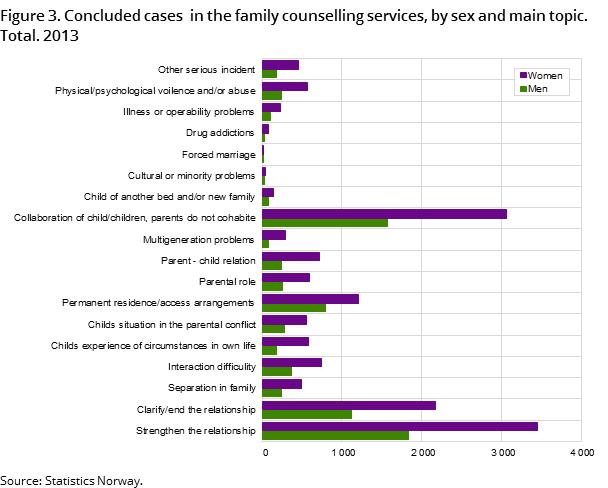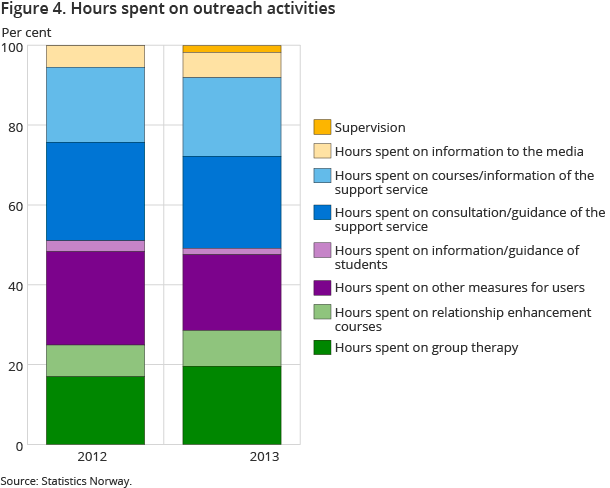Content
Published:
This is an archived release.
More family counselling cases of longer duration
The family counselling offices dealt with 32 175 cases in 2013; an increase of 2 per cent from the year before. More people contacted family counselling offices in connection with their relationship, unmarried people were more strongly represented in the cases, the cases were of a longer duration and clients and employees were predominantly women.
| 2013 | |
|---|---|
| New cases | |
| Both sexes | 25 178 |
| Males | 8 318 |
| Females | 16 860 |
| Region East | 9 810 |
| Region South | 4 825 |
| Region West | 4 089 |
| Region Middle | 3 199 |
| Region North | 3 255 |
| Average waiting time per case (days) | 31 |
| Average duration per case | 146 |




In all regions, except for Region South, there was an increase in the number of family counselling service cases. In Region South there was a decrease of 1 per cent in the number of cases. Region North had most cases in relation to the number of inhabitants, i.e. 8.2 per 1 000 inhabitants. As in previous years, Region West had the lowest number of family counselling cases; 5.0 per 1 000 inhabitants.
Relationship was the main reason for contact
In 2013, there were roughly 25 200 new cases. In 43 per cent of these cases, issues relating to their relationship were the main reason for the enquiry. About 39 per cent of the clients contacted a family counselling office for parental collaboration or guidance. Fifteen per cent of the enquiries related to “Other or complex family problems” and in 3 per cent of the cases, help for children and adolescents was the reason for enquiry.
Mostly unmarried people who make contact
Clients at the family counselling offices tend to be predominantly women, and the year 2013 was no exception. Sixty-eight per cent of those who made contact with family counselling were women, and 32 per cent were men. Forty-two per cent were aged 35-44, 27 per cent 25-34 years and 24 per cent were over 45 years. The proportion under 25 years was 6 per cent in 2013. Thus, the gender and age distribution of clients of the family counselling services is very similar to the previous year.
Among the 33 175 people who contacted the family welfare offices in 2013, the primary clients, the proportion of unmarried persons was highest (46 per cent). This represents an increase of 1 percentage point from the previous year. There was also a 1 percentage point decrease for married and registered partners, accounting for 35 per cent of those who made contact. For legally separated persons, the share remained steady at 7 per cent. With regard to the proportion of divorced clients, there was a decrease of 1 percentage point. Divorced clients amounted to 11 per cent of those who contacted the family counselling services in 2013.
Increased share of children as participants, and more parents’ counselling
The total number of sessions in 2013 increased by 5 per cent from the previous year. Forty-three per cent of the 102 040 sessions in 2013 included a partner. Former partners took part in 15 per cent of the sessions, and children under 18 years of age were represented in 6 per cent, which is an increase of 1 percentage point from the year before. The average number of sessions per family counselling case during the year was 3 sessions.
Couple counselling continued to make up the greatest share of cases, with 39 per cent. In 2013, there was, however, an increase from the year before in the share of parents’ counselling, from 22 to 24 per cent of all the cases.
Fewer closed cases – longer waiting times and duration
There were 25 178 new family counselling cases in 2013; an increase of 1 per cent from the year before. The average waiting time per case was 31 days; an increase of 2 days from the year before. The average treatment time after the first session was 146 days for the cases that were closed in 2013, compared with 140 days the previous year. The number of closed cases was reduced by 2 per cent from the year before. In other words, there were more new cases in 2013 than the year before, but fewer closed cases. More sessions were spent on the clients, and both the waiting time and processing time in days increased.
Strengthening the relationship was the main subject
The main reason for the largest share of family counselling cases closed in 2013 was to strengthen the relationship. Cooperation in relation to children where parents do not live together was the main subject for 20 per cent, and in 14 per cent of the cases the main theme was to clarify/end the relationship. These shares were similar for men and women. Permanent residence/access arrangements was another common theme for men, while the child’s perception of their own situation and the parent/child relationship was more common for women.
Women dominate the family counselling offices
In 2013, the number of man-years in the family counselling service was 427; an increase of 3 man-years from 2012. With regard to the number of man-years per 10 000 inhabitants, there are almost no changes from 2012 (0.8).
Thirty-nine of the employees at the family counselling offices in 2013 were social workers or child welfare officers, 25 per cent were psychologists, 13 per cent had other health care qualifications from college or university, and 7 per cent had other qualifications from college or university. Nine per cent had an upper secondary education, and 8 per cent had an education below upper secondary, including unknown education.
Sixty-one per cent of the employees were older than 50 years, and 73 per cent were woman. Forty-five per cent of all man-years in the family counselling services were carried out by women older than 50 years.
Violence and abuse as main topic for groups
In 2013, the family counselling services worked with 68 clinical groups; 43 individual groups, 11 couples, 8 groups of children younger than 18 years and 6 family groups. These groups carried out 706 group meetings in 2013. Separation in the family was the theme for 18 of the groups, and 12 groups had relationship as a theme. However, the theme in group sessions for most groups (30) was violence or abuse.
Reduction in external activities
Family counselling cases make up only one of many areas that family counselling offices work with. For example, courses and guidance for students, the support services and the general public also make up a large share of the work. Hours spent on this external activities were just over 20 650 in 2013. This is a reduction of 3 per cent compared to the year before.
The national child welfare and family counselling service spent almost NOK 356 million on family counselling in 2013; an increase of 3 per cent from the previous year.
The family counselling offices are the core unit in the Norwegian mediation service, and mediation is a major task in the family counselling service. More than 19 600 mediations for parents were completed in 2013.
Re-adjustments and break in time series with effect from 2013Open and readClose
The family counselling statistics have been re-adjusted with effect from the 2013 figures. There is new information about the main topic of the cases, client groups in family counselling and man-years in family counselling. Man-years are now collected from Statistics Norway's registers, and no longer via electronic forms. This has led to the introduction of a new definition of man-years from 2013. For outreach activities in family counselling, figures are collected from the family counselling offices’ computers systems, instead of from electronic forms.
Contact
-
Vibeke Sky
E-mail: vibeke.sky@ssb.no
tel.: (+47) 40 90 24 05
-
Unni Beate Grebstad
E-mail: unni.grebstad@ssb.no
tel.: (+47) 94 50 68 66
